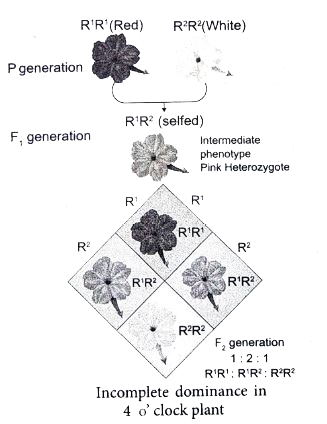Differentiate incomplete dominance and codominance.Solution in Tamil
The German Botainst Carl Correns.s (1905) , Experiment - In 4 O. clock plant, Mirabilis Jalapa when the pure breeding homozygous red (R1R1) parent is crossed with homozygous white (R2R2) , the phenotype of the F1 hybrid is heterozygous pink (R1R2) . The F1 heterozygous phenotype differs from both the parental homozygous phenotype. This cross did not exhibit the character of the dominant parent but an intermediate of the dominant parent but an intermediate colour pink. When one allele is not completely dominant to another . allel it shows incomplete dominance. Such allelic interaction is known as incomplete dominance . F1 generation produces intermediate phenotype pink coloured flower.

When pink coloured plant of F1 generation were interbred in F2 both phenotypic and genotypic ratios were found to be identical as 1:2:1 (1 red : 2 pink : 1 white) . Genotypic ratio is 1R1R1:2R1R2:1R2R2 From this we conclude that the alleles themselves remain discrete and unltered proving the Mendel .s Law of Segregation . The phenotypic and genotypeic ratios are the same . There is not blending of genes . In the F2 generation R1andR2 genes segregate and recombine to produce red, pink and white in the ratio of 1 : 2 : 1. R1 allele codes for an enzyme responsible for the formation of red pigment . R2 allele codes for deceive enzyme . R1andR2 genotypes produce only enough to make the flower pink. Two R1R1 are needed for producing red flowers. Two R2R2 genes are needed for white flowers. If blending had taken place , the original pure traits would not have appeared and all F2 plants would have pink flowers . It is very clear that Mendel.s particulate inheritance takes place in this cross which is confirmed by the reappearance of original phenotype in F2.
Topper's Solved these Questions
- CLASSICAL GENETICS BOOK - FULL MARKSCHAPTER - CLASSICAL GENETICS EXERCISE - Higher Order Thinking Skills (HOTs) Questions
5 Videos
- CLASSICAL GENETICS BOOK - FULL MARKSCHAPTER - CLASSICAL GENETICS EXERCISE - Additional Questions (3- Mark Questios)
8 Videos
- CHROMOSOMAL BASIS OF INHERITANCE BOOK - FULL MARKSCHAPTER - CHROMOSOMAL BASIS OF INHERITANCE EXERCISE - Higher Order Thinking Skills (HOTs) Questions
3 Videos
- ECONOMICALLY USEFUL PLANTS AND ENTREPRENEURIAL BOTANYBOOK - FULL MARKSCHAPTER - ECONOMICALLY USEFUL PLANTS AND ENTREPRENEURIAL BOTANYEXERCISE - HIGHER ORDER THINKING SKILLS (HOTs) QUESTIONS
5 Videos
Similar Questions
A yellow colour flower plant indicated by YY is crossed with white color flower plant denoted by yy.
(a) following the Mendelian inheritance pattern , what would be the flower color is first filial generation ?
(b) Which Mendelian principle is illustrated in this cross ?
(c) Derive the cross and state the phenotypic ratio of yellow flowers to white flowers in F2 generation ?
View SolutionPoint out any three importance of variations.
View SolutionGiven below is a sequence of alphabets representing the genes of chromosome. Observe it and answer the questions.
A - B - C - D - E - F - G - H - I - J - K .
(a) Write the sequence of genes after the chromosome undergoes terminal deletion of single gene.
(b) What will be the gene sequence, if the genes E and F undergoes tandem duplication ?
(c) Consider the centromere is located between the genes F and G and write a gene sequence , after parametric inversion occurs in between the genes C, D and E.
View SolutionThe following are the binomials of economically useful plants. Mention their respective families.
(a) Borassus flabellifer
(b) Mangifera indica
( c) Saccharum officinarum
(d) Curcuma longa
(e) Capsicum annum
(f) Tamarindus indica
View SolutionDifferentiate complete and incomplete digestive system.
View SolutionDifferentiate incomplete dominance and codominance.
View SolutionDifferentiate between incomplete dominance and co-dominance.
View SolutionDifferentiate between codominance and dominance.
View SolutionDifferentiate between epistasis and dominance.
View SolutionDifferentiate between complete linkage and incomplete linkage.
View SolutionDifferentiate between the following:
Dominance and Recessive
View SolutionDifferentiate dominant allele and recessive allele.
View SolutionDifferentiate between the following : Dominance and Recessive
View SolutionDifferentiate between complete and incomplete digestive systems.
View SolutionDifferentiate between Epistasis and Dominance
View SolutionDifferentiate between Codominance and Incomplete dominance
View Solution
